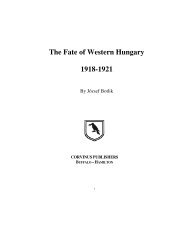The Tsangos of Romania - Corvinus Library - Hungarian History
The Tsangos of Romania - Corvinus Library - Hungarian History
The Tsangos of Romania - Corvinus Library - Hungarian History
You also want an ePaper? Increase the reach of your titles
YUMPU automatically turns print PDFs into web optimized ePapers that Google loves.
4. Bogdán voivode <strong>of</strong> Máramaros 1359-13655. Lackó 1365-1373<strong>The</strong> troops, sent by king Lajos in 1343, after completelydriving out the Tartars, named Drágos as the Voivode <strong>of</strong>Moldavia which was under the authority <strong>of</strong> the <strong>Hungarian</strong> king.Szász and Balk followed him. In 1359, Bogdan, who was theVoivode <strong>of</strong> Máramaros went to Moldavia, defeated the king'sarmy stationed there, drove Balk away, and made himselfVoivode <strong>of</strong> Moldavia. In 1370, his son Lackó, who was willingto leave the pagan ways <strong>of</strong> his ancestors asked the pope for abishopric in Szeret (Siret). On the 9th <strong>of</strong> March, 1371, Andrásbecame the first bishop <strong>of</strong> Szeret. In the same year, Lackósurrendered to the king and as a sign <strong>of</strong> his faithfulness, hestarted to pay taxes. With the death <strong>of</strong> Lackó, the connection <strong>of</strong>Hungary and Moldavia became weaker and the relationship withPoland grew stronger. Both Petru Musat and Roman Voivodeswere the people <strong>of</strong> the Polish king. Many new metropolitanswere established, but at the same time in 1410 the fifth bishopricwas established in Moldvabánya.HUSSITE MOVEMENTSJohn Huss, introduced new teachings in 14oo, whichspread like wildfire all over the country. But as soon as thesenew teachings appeared, the church started the persecution <strong>of</strong>it's members. Those people who had accepted the teachings, hadto escape and Moldavia was open since there they werewelcome. This is when the town Husz /Husi/ was built. Animportant part <strong>of</strong> the teachings <strong>of</strong> Huss was, that preaching andreading the Bible, had to be in the mother tongue and since atthat time the Bible wasn't translated into <strong>Hungarian</strong>, TamásPécsi and Bálint Újlaki set to it at once. Although the originaltranslation was not found by the historians, copies remained inthe Vienna-codex, München-codex, and in the Apor-codex.<strong>The</strong> number <strong>of</strong> those who accepted the dogmas <strong>of</strong> Huss,was enormous in Moldavia. Apart from the movement, we findthat at the time newer and newer towns and villages are settled,and from the turn <strong>of</strong> the century we know the names <strong>of</strong> Bratilla,Mánfalva, Vasló, Bersence, and Leontinfalva villages. In 1408,newer villages can be found on the map and these are Tatros,Bákó, and Románvásár. <strong>The</strong>n in 1420, still other village names
















